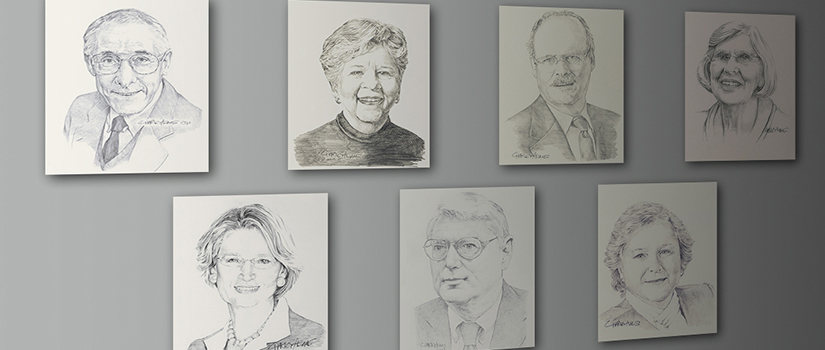November 1, 2016 | Erin Bluvas, bluvase@sc.edu
The Department of Communication Sciences and Disorders (COMD) has experienced numerous changes and tremendous growth over its 48-year history. Through their nearly five decades of education, research, and service, the department has relied on the contributions of many influential individuals who have made significant contributions to the department over the years. Beginning in the early 2000s, COMD began paying tribute to these leaders through commissioning portraits of them.
Arthur (Art) Weiss was the founding chair of the department (then known as Speech-Language Pathology and Audiology) back when it was established in the College of Education in 1968. He is credited with developing the first master’s degree program for speech pathology and audiology in South Carolina.
Gale Coston (married to Carol Coston) led the department as chair (beginning in 1973) when it transitioned from the College of Education to become one of the original departments within the Arnold School of Public Health (then known as the College of Public Health and Associated Health Programs) in 1975. Coston was influential in developing South Carolina’s first Cleft Palate/Craniofacial Clinic. He also held roles as Associate Dean of Academic Affairs and Interim Dean for the Arnold School and Associate Vice President for Instruction at USC.
Carol Coston (married to Gale Coston) served as director of the department’s USC Speech and Hearing Research Center from 1973-1988. She established the external practicum placement program within the department’s master’s degree program so that students could gain clinical experience both within the Center and in locations such as schools and hospitals.
Bill Cooper served as the chair of the department from 1981 to 1983 and 1996 to 1998, during which time he presided over the development of the department’s Cochlear Implant Program. In between his terms as chair he served as the department’s Graduate Director (1989 to 1996). Cooper is a Fellow of the American Speech-Language-Hearing Association, an Honors recipient of the South Carolina Speech-Language-Hearing Association, and former Chair the South Carolina’s licensure board in speech pathology and audiology. A prolific scholar and researcher, he published more than 50 peer-reviewed journal articles, presented over 100 papers at scientific meetings, and generated well over one million dollars in extramural research funding.
Sharon Webber is an alumna of the department’s master in speech-language pathology program (1981) who established, with her husband Thomas Webber, Super Duper ®Publications, a Greenville-based company that develops learning materials for children, in 1986. She and her husband continue to support the department with an annual student scholarship and donations of her company’s products to the Center and students.
Judy Martin led the USC Speech and Hearing Research Center as the Center director during the 1990s. She remained an adjunct faculty member, teaching a master’s level course on fluency, through the 2000s—until this year. Martin was presented with her own copy of her portrait when it was unveiled at the department’s 2016 Something to Talk About Fundraiser.
Elaine Frank was a two-time COMD alumna and long-time faculty member. She served as the department chair for more than a dozen years (1999-2012) and is credited with strengthening the department’s academic, clinical, and research programs during a time of significant expansion. Frank is also known for more fully integrating the department’s research activities with the clinical treatment and education that takes place at the USC Speech and Hearing Research Center.
The portraits were drawn by COMD Clinical Assistant Professor Charley Adams, who has been lending his talent to creating portraits of South Carolina Business Hall of Fame inductees since the 1980s. “The department realized it could draw on the talent of one of its own faculty members to pay tribute to these individuals,” says current COMD Chair Kenn Apel. “At the same time, the portraits help students and visitors understand the impact they had made to the department and the Center.”
